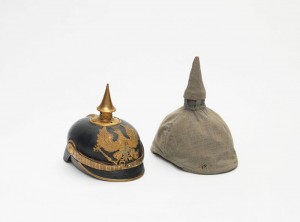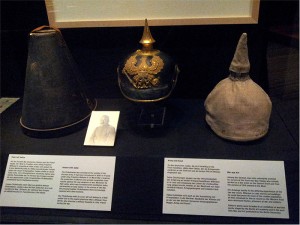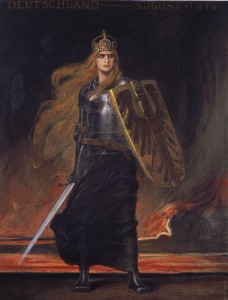“Our inclination to hopefulness and expectations of a final victory are unabated and yet the long wait does at times begin to worry us.”
The cultural and literary historian Ludwig Geiger, son of the famous reformist rabbi Abraham Geiger, penned these lines to a friend on 5 December 1914. The “long wait” which had started to trouble him four months after the Great War broke out, ultimately dragged on for almost four more years and yet failed to bring the victory so yearned for. Soldiers at the time could barely imagine what massive destruction this first modern war would wreak. The paltry equipment with which they set off for the front is proof enough of that.

Dr Max Litthauer’s Pickelhaube (spiked helmet) with camouflage covering, 1914–1918. Donated by Bart Ullstein © Jewish Museum Berlin, photo: Jens Ziehe.
On display both in the exhibition “The First World War in Jewish Memory” at the Jewish Museum Berlin and in the special exhibition “1914–1918. The First World War” at the German Historical Museum (DHM) are Pickelhauben, spiked helmets made of hardened (boiled) leather and with a cloth covering for camouflage—for a metal spike protruding above a trench and catching the sunlight made its wearer a sitting target. On my guided tours of the two exhibitions, I take the Pickelhaube as an opportunity to talk about how much this war differed from previous ones as well as how ill-prepared the military was, initially, for the new weaponry deployed.
Each exhibition pursues a different angle. The cabinet exhibition draws exclusively on the Jewish Museum’s own collections to present an arresting display of artifacts and documents that were of great sentimental value to Jewish families even after the war was over. The exhibition at the DHM, on the other hand, provides an overview of the events, with selected battle sites and scenes from the home front presented by way of example; hence two entirely different concepts—yet with an astonishing number of parallels.

Dr Max Litthauer’s Pickelhaube (spiked helmet) with camouflage covering and hatbox, 1914–1918. Donated by Bart Ullstein, photo: Friedrun Portele-Anyangbe
Much about the First World War can be read, heard and seen in this centenary year of remembrance. Therefore, many visitors, including older schoolchildren, are remarkably well informed about the history of the First World War (although more boys than girls in the latter case). So, I must ask myself, repeatedly, how I may best rouse and rivet their interest. In business, everything revolves around the USP, the unique selling point. Museums’ USP is that their exhibits turn abstract history into a concrete reality. I accordingly encourage the visitors on my tours to take a very close look at exhibits and I am always delighted when they discover surprising or unexpected features. For the strength of the exhibits in these two exhibitions lies precisely in the stories they tell! Among the eloquent items on display in the Jewish Museum number two Yads (Torah pointers) and field prayer books as well as the honor crosses awarded to war veterans in 1934, which certain Jewish veterans already in exile were presented with at German consulates abroad.
The German Historical Museum presents an armband worn by the field rabbi Aron Tänzer as well as the medals awarded the Jewish fighter pilot Paul Hagen. On my tours there I like to point out well-known exhibits, too, such as Friedrich August von Kaulbach’s painting “Germania,” a determined and fierce female figure, ready to fight but in a defensive posture—the artist’s representation of Germany in August 1914.

Germania. Friedrich August von Kaulbach, oil on canvas, Germany 1914 © Stiftung Deutsches Historisches Museum
How would we paint “Germania” today? How has Germany changed over the last one hundred years? Pondering such questions has amusing, interesting and thought-provoking results…
Ludwig Geiger died shortly after the end of the First World War, in early 1919, aged 70. He was unable to reconcile himself with the revolution that cost “Germania” her crown.
Friedrun Portele-Anyangbe, Guide